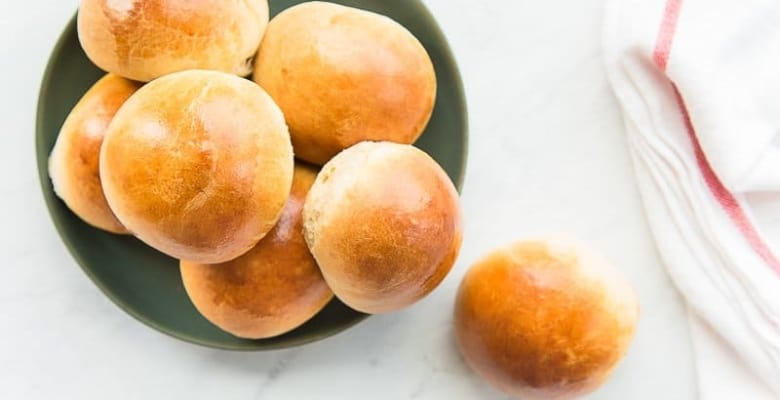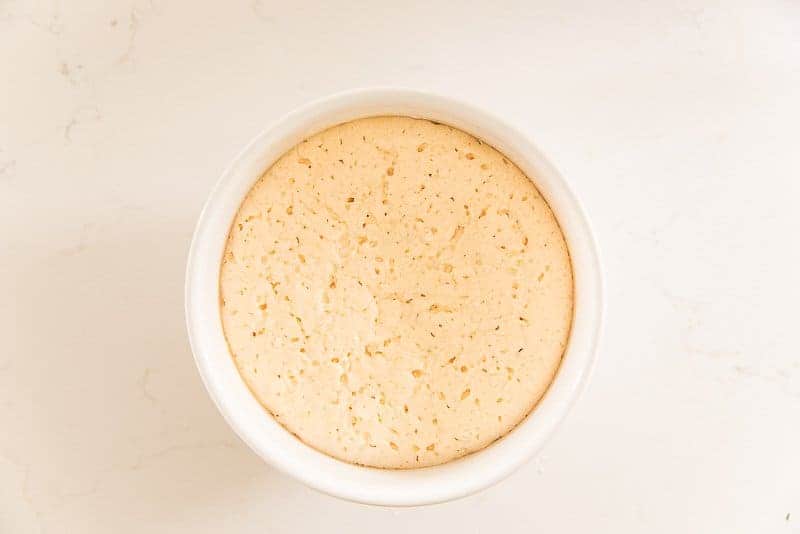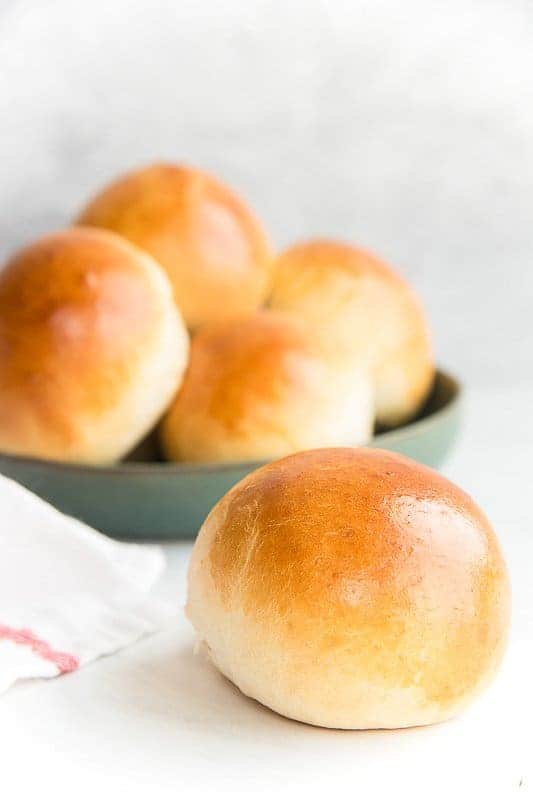If you’re looking for an alternative to boring yeast rolls, might I tempt you with my wares? These Brioche Rolls are buttery, rich bread rolls with a fluffy interior and yeasty flavor. Your dinner table won’t know what hit it. These rolls are a great addition to your holiday menus or to serve at your everyday dinners. Be sure to check out the notes for tips on how to prep these ahead for your busiest seasons.

What are Brioche Rolls?
Brioche bread is a bread that originated in France. Because it’s made with a generous amount of butter and eggs, brioche is considered an enriched yeast bread. That higher amount of eggs and butter doesn’t mean the bread is dense. Instead, it is light and fluffy. Brioche is also sweeter than your typical sandwich bread because of the added sugar and, in this recipe, honey. Don’t think of it as a “cinnamon roll sweet,” though; the sweetness is more like my Pan Sobao.
Brioche rolls are just mini balls of brioche dough baked in a freeform bun shape. They can be enjoyed on their own, slathered in butter (yes, more butter) or jam, or used as sandwich bread. You can use brioche rolls as the foundation for this Budín de Coquito or this Raspberry White Chocolate Bread Pudding.
What do I need to make them?
To make this recipe, you need bread flour, eggs, salt, sugar, unsalted butter, honey, whole milk, and active dry yeast. Before baking, the raw dough is brushed with an egg wash made with an egg and water. I’ll also walk you through optional toppings below and in the recipe card.
What does a sponge do in the Brioche Rolls?
Start by making a sponge. Sponges not only help bread doughs rise and give them a tender, fluffy crumb; sponges also give brioche rolls a deep, malty flavor that makes them taste so amazing. Using a sponge also gives the yeast in bread dough more time alone to work and gives the brioche rolls that malty, more nuanced flavor after baking.
When you add the yeast to warm milk, you are “blooming it.” This is how to check that your yeast is actually alive.
When activating the yeast, don’t use milk that’s too hot or too cold. Cold milk won’t activate the yeast, and milk that’s too hot will kill it. The milk needs to be 110°F (43°C). If it’s hotter than that, cool it off when you pull it from the microwave or stove until it reaches a safe temperature.
Stir the yeast into the milk with the honey. Within 5 minutes, the yeast will start to move and eventually foam up as it heats up with the milk. If there’s no movement in the bowl after 5 minutes, the yeast is dead. Go ahead and dump the mixture out and start over with a new jar of yeast.
To finish the sponge for the brioche, use a rubber spatula to combine the first portion of bread flour with the yeast-milk mixture in a 3-quart mixing bowl. Choose a good-size mixing bowl because the sponge will rise as the yeast ferments. Once the mixture resembles a thick batter, cover it with a clean kitchen towel and set it in a warm, draft-free place in the kitchen. I always put mine in the microwave.
After 30 minutes in that warm area, the mixture will double in volume and look spongy, which is so on-brand.
How do I finish the dough?
Brioche roll dough should be made with room-temperature eggs and butter, so the dough mixes properly.
To the bowl of your 5-quart (or larger) stand mixer, fitted with the paddle attachment, add the sponge, eggs, sugar, and salt. Because salt kills yeast, add it last, so it doesn’t have contact with the sponge.
Add a portion of the bread flour to the bowl.
Blend this mixture together on 2nd speed until it is smooth. Once a thick batter forms, add another cup of bread flour.
After you add that cup of bread flour, switch to the dough hook because the dough will be stiff.
Mix again on 2nd speed and add the remaining bread flour.
Since this is such an enriched dough, varying factors might affect how much flour you need to add to your brioche dough. Weather is the biggest factor in how much flour you’ll eventually add to your bread dough. If the weather is very hot and humid the day you make your bread, you might need up to 3/4 cup more flour. Just be prepared to add additional bread flour as needed.
How soft does the butter have to be before adding it to the dough?
Butter for brioche dough must be soft enough to be incorporated into the dough without turning it into a gooey mess. It needs to feel a little cool to the touch and squish slightly. It’s too soft if it melts in between your fingers. Put it into the fridge for 5 minutes to firm up. Zap it for 10 seconds in the microwave if it feels rock hard. Usually, cutting the butter into tablespoons and letting it sit out while you measure everything else and get the sponge going gives it enough time to come to the right temperature.
Add the unsalted butter into the dough as it’s kneading, two tablespoons at a time. The dough will absorb the butter, and that’s when it’s time to add the next two tablespoons. Press the next pat of butter between your fingers to give it a head start while waiting for the previous addition to mix in.
Once you add the butter, continue kneading the dough on second speed for 10 minutes. The dough will be soft, pliable, and smooth at the end of mixing.
How long does the dough need to rise?
Take the dough out of the bowl and lightly grease the inside of the bowl with softened butter or a neutral-tasting oil. Return the dough to the bowl and turn it to cover the surface of the dough with a protective layer of fat.
Cover the bowl with plastic film or a kitchen towel and allow the dough to rise for an hour or until it’s doubled in bulk.
Punch the dough down after 1 hour to dispel the gases produced during rising. Next, turn the brioche dough onto a floured surface and knead it 3 or 4 times. This redistributes the yeast in the dough, which means we get a little more volume in our brioche rolls.
How do I form the Brioche Rolls?
Weighing out your brioche dough on a scale is the key to forming brioche rolls that are all the same size.
Use a bench scraper to cut off 1-ounce (30 grams) pieces of dough. To make brioche buns, weigh them out in 4-ounce (120 grams) portions. For rolls that are not as big as buns but heartier than dinner rolls, weigh out 2-ounce (60 grams) balls. The heavier your balls of dough are, the fewer rolls you’ll get. As written, you’re going to get 24 brioche rolls.
Hold your hands like you’re going to karate chop someone in the throat. Now curl your fingers in to form a “C.” Use the fleshy- non-thumb- side of your “C” hands to push the dough ball against the countertop to form it into a smooth ball. The movement, coupled with the way your hands are formed, presses the balls of dough into shape.
After forming the brioche rolls, put them onto a sheetpan lined with parchment paper or a silicone baking mat. You can give them an inch or two of space or nestle them closer than an inch. If you want perfectly round rolls, spread them out 2-inches.
Cover the rolls with a kitchen towel and allow them to rise in a warm place for 30 minutes or until slightly doubled in volume. Preheat the oven to 350°F (180°C) right after covering them.
Can I make the dough ahead and bake them later?
Yes, you can form the brioche rolls and store them in the fridge to bake later.
Transfer the dough balls to a sheetpan and keep them covered in the fridge for 24 hours. They have to warm up to room temperature, then go through their second rise after cooling, though.
You can also freeze the brioche roll dough. Arrange the dough on a sheetpan so they’re not touching, and cover them lightly with plastic film. Freeze the balls of dough solid, then transfer them to a freezer storage bag and freeze the brioche rolls for 2 months. Before baking, thaw the brioche rolls completely in the fridge. You still have to warm them up for about 30 minutes, then allow the dough to rise for the additional 30 minutes before baking.
How can I customize my Brioche Rolls?
Whisk together the egg wash just before the second rising time is up.
In a small mixing bowl, use a whisk to vigorously beat together a large egg and 1 tablespoon of cold water until runny. The egg wash gives brioche rolls their shiny crusts and adds overall color to the bread.
You can bake the brioche rolls plain after glazing them with the egg wash or customize them with:
- White or black sesame seeds
- Poppy seeds
- Everything Bagel Seasoning
- Maldon sea salt
- Grated parmesan cheese
How do I know when my Brioche Rolls are done baking?
Bake brioche rolls for 15-18 minutes, or until golden brown. The brioche rolls will sound hollow when you thump their undersides with your fingers.
Remove the pan of bread from the oven and allow the brioche rolls to cool on the pan for 5 minutes. Transfer the rolls to a cooling rack or serve them straight from the pan piping hot.
How do I serve them?
I’ve never needed a reason or instructions on serving brioche rolls, but I’m not here for me.
Serve brioche rolls warm with your favorite salted butter, fruit preserves, or spread. You can also eat these rolls on their own. Brioche rolls turn boring egg sandwiches into something unreal. Or, dip them in your morning cup of coffee.
How do I store leftover Brioche Rolls?
Store leftover brioche rolls in an airtight food storage bag or container. The air causes bread to go stale, so avoid exposing the rolls to too much of it.
Don’t store brioche rolls in the refrigerator. Cold air causes them to go stale faster. You can store brioche rolls at room temperature on the counter or in a bread box for up to 5 days.
To “freshen” up the flavor of leftover brioche rolls, wrap them in a damp kitchen towel and warm them in the microwave for a few seconds.
Can I freeze leftover Brioche Rolls?
Yes, you can freeze baked brioche rolls for up to 2 months. I often do that ahead of holiday meals, in fact.
To freeze baked brioche rolls, allow them to cool completely. Transfer the rolls to a freezer-safe storage bag and freeze them for 2 months. To thaw, just pull the bread bag out of the freezer and put it on the counter.
Make these rolls the highlight of your next family dinner. Be sure to pin the recipe to your breads board and share it, too!

Brioche Rolls
at Sense & EdibilityEquipment
- 5-quart (or larger) stand mixer
Ingredients
For the Brioche Rolls Sponge
- 1 cup (240 milliliters) whole milk warmed to 110°F (45°C)
- 1/4 cup (60 milliliters) honey
- 1 tablespoon (11 grams) active dry yeast
- 1 cup (120 grams) bread flour
For the Brioche Dough
- brioche sponge
- 8 large eggs at room temperature
- 1/2 cup (100 grams) granulated sugar
- 2 teaspoons (12 grams) kosher salt
- 6-6 1/2 cups (720-780 grams) bread flour plus more for forming the rolls
- 1 cup (226 grams) unsalted butter sliced and at room temperature
For the Egg Wash
- 1 large egg
- 1 tablespoon (15 milliliters) cold water
Optional Toppings
- white or black sesame seeds
- poppy seeds
- maldon sea salt
- everything bagel seasoning
- grated parmesan cheese
Instructions
Make the Brioche Rolls Sponge
- In a 3-quart mixing bowl, stir together the warm milk and honey until combined. Sprinkle the active dry yeast over the surface of the mix and stir it to saturate it in the milk mixture. Within 5 minutes, the yeast will start to move and eventually foam up and smell like beer. If there's no movement in the bowl after 5 minutes, the yeast is dead. Go ahead and dump the mixture out and start over with a new jar of yeast.
- After the yeast shows signs of life (or 5 minutes), use a rubber spatula to stir in the 1st cup of bread flour. Once the mixture resembles a thick batter, cover it with a clean kitchen towel and set it in a warm, draft-free place in the kitchen (a microwave is great). Allow the sponge to rise for 30 minutes.
Finish the Brioche Rolls Dough
- Add the brioche sponge, eggs, sugar, salt, and 2 cups of the bread flour to the bowl of a 5-quart (or larger) standMix these ingrediets together with the paddle attachment on 2nd speed until it is smooth. Once a thick batter forms, add another cup of bread flour. Blend until a verystiff dough forms.
- Switch to the dough hook . After switching to the dough hook, mix again on 2nd speed and gradually add the remaining bread flour*.
Gradually Add the Butter
- Add the unsalted butter, two tablespoons at a time, into the dough as it's mixing.Once the butter is absorbed (no longer visible), add the next two tablespoons. Once you add all of the butter, continue kneading the dough on second speed for 10 minutes.
- The dough will be soft, pliable, and smooth at the end of mixing.Take the dough out of the bowl and lightly grease the inside of the bowl with softened butter or a neutral-tasting oil. Return the dough to the bowl and turn it to cover the surface of the dough with a protective layer of fat.
Allow the Dough to Rise
- Cover the bowl with plastic film or a kitchen towel and allow the dough to rise for an hour or until it's doubled in bulk. Punch the dough down after 1 hour to dispel the gases produced during rising.
- Next, turn the brioche dough onto a floured surface and knead it 3 or 4 times to redistributes the yeast in the dough.
Scale, then Form the Brioche Rolls
- Use a bench scraper to cut off 1-ounce (30 grams) pieces of dough. Hold your hands in a karate chop, then curl your fingers in to form a "C." Use the fleshy- non-thumb- side of your "C" hands to push the dough ball against the countertop to form it into a smooth ball. You shouldn't need additional flour as the dough shouldn't be sticky, but if so, sprinkle the countertop lightly.
- After forming the brioche rolls, put them onto a sheetpan lined with parchment paper or a silicone baking mat. Cover the rolls with a kitchen towel and allow them to rise in a warm place for 30 minutes or until slightly doubled in volume.
Make the Egg Wash
- Preheat the oven to 350°F (180°C) right after covering the rolls.In a small mixing bowl, use a whisk to vigorously beat together a large egg and 1 tablespoon of cold water until runny. Set the egg wash aside.
Bake the Brioche Rolls
- Brush each brioche roll with a liberal layer of egg wash. Sprinkle on toppings as desired. Bake brioche rolls for 15-18 minutes, or until golden brown. The brioche rolls should sound hollow when you thump their undersides with your fingers.
- Remove the pan of bread from the oven and allow the brioche rolls to cool on the pan for 5 minutes. Transfer the rolls to a cooling rack or serve them straight from the pan piping hot.
Notes
Swaps and Substitutions:
- You can skip the sponge and replace the active dry yeast with instant yeast, adding it to the eggs in the mixing bowl, but your brioche rolls won't be as fluffy or flavorful as they would when made with active dry yeast.
- You can replace the bread flour with all-purpose flour but it will result in brioche rolls that are less chewy or "bready."
- To make brioche buns, weigh them out in 4-ounce (120 grams) portions. For rolls that are not as big as buns but heartier than dinner rolls, weigh out 2-ounce (60 grams) balls.
Tips and Techniques:
- *If the weather is very hot and humid the day you make your bread, you might need up to 3/4 cup more flour. Just be prepared to add additional bread flour as needed.
- Butter for brioche dough must be soft enough to be incorporated into the dough without turning it into a gooey mess.
- The heavier your balls of dough are, the fewer rolls you'll get.
- If you want perfectly round rolls, spread them out 2-inches.
- To "freshen" up the flavor of leftover brioche rolls, wrap them in a damp kitchen towel and warm them in the microwave for a few seconds.
Make Ahead Instructions:
You can start the sponge up to 48 hours ahead, but after 30 minutes, put it into the fridge. To make the raw brioche rolls ahead:- Form the brioche rolls and transfer them to a sheetpan.
- Cover the pan with plastic film and store it in the fridge for 24 hours.
- Allow the dough to warm up to room temperature, give them a second rise and proceed as instructed.
Storage Instructions:
- Store leftover brioche rolls in an airtight food storage bag or container.
- Don't store brioche rolls in the refrigerator. Cold air causes them to go stale faster.
- You can store brioche rolls at room temperature on the counter or in a bread box for up to 5 days.
Freezing Instructions:
To freeze the raw brioche roll dough-- Arrange the dough on a sheetpan so they're not touching, and cover the pan lightly with plastic film.
- Freeze the balls of dough solid, then transfer them to a freezer storage bag and freeze the brioche rolls for 2 months.
- Before baking, thaw the brioche rolls completely in the fridge. You will have to warm them up for about 30 minutes at room temperature.
- Allow the dough to rise for the additional 30 minutes before baking.
- Allow them to cool completely.
- Transfer the rolls to a freezer-safe storage bag and freeze them for 2 months.
- To thaw, just pull the bread bag out of the freezer and put it on the counter.























Nothing to comment except a single word—PERFECTION.
We’ll take perfection. 😊
Oh my gosh yum! This looks so tasty, I love brioche buns I totally need to make these
They are amazing, Bella.
These look so good! I always have the worst time with yeast even when I measure the temp! But I’m gonna have to try these rolls they look so yummy
You’re going to do great, Tisha!
These look really good! I love that you can have kinds of toppings/seasoning on it. I’d love to have sesame seeds on mine!
Your imagination is the only boundary, Nadalie. Explore!
They look so fluffy! I need to make them for breakfast over the weekend
They are SO fluffy, Mimi. You’re going to love them.